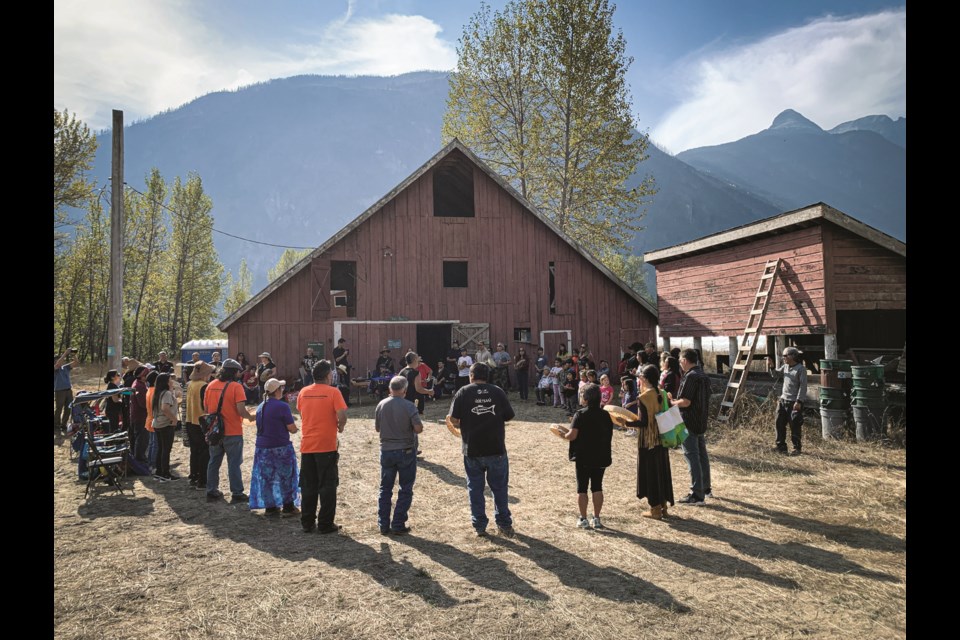An agreement returning 98 hectares of Pemberton-area land to the Lil’wat Nation was a long time coming, according to Lil’wat Nation Skalulmecw Chief Dean Nelson—but the deal represents much more than just land.
“It’s very important to acknowledge the land and the ancestors, because we always had a connection with them, so [with this agreement], we’ve kind of reconnected back with them, the way it should be,” Nelson said, at a ceremony commemorating the agreement on Oct. 7.
“I feel very happy to be part of it, doing this part for the Lil’wat people, and having everyone, the school district, [attending the ceremony]. I’m really happy to be here today.”
Lil’wat Nation and School District 48 representatives signed the agreement officially transferring ownership of the land—the former Coast Mountain Outdoor School lands, located at 9485 Upper Lillooet River Forest Service Road at the very end of the Pemberton Meadows—back to the Lil’wat at the ceremony.
The agreement is one of the most significant land transfers in Sea to Sky history and, at 98 hectares spread over three separate parcels, the largest in the Lil’wat Nation’s modern history.
The land was previously home to the Coast Mountain Outdoor School (CMOS), one of a handful of nature-focused education facilities in the province that provided students with opportunities for outdoor education.
Though the facility was closed for good in 1995, the school district continued to spend money on the upkeep of the property, and its future remained unclear for years.
Today, the property holds older cabins, a barn, and associated buildings from days long past, some of which require repair.
According to Rebecca Barley, SD48 board chair and school trustee for Squamish-Lillooet Regional District Area C, which includes the old CMOS property, the process to transfer the land back to the Lil’wat Nation took some time, and required working closely with the provincial government and Ministry of Education.
“I’d say this last year was really when the push came. I think Truth and Reconciliation had much to do with that. The district has always acknowledged that this is part of St’át’imc, part of Lil’wat territory,” Barley said in a speech at the signing ceremony.
“Staff from both Lil’wat and the school district have worked very hard to see this through and get the proper permissions in place. Both have been supported by their leadership in doing so. It is an absolute honour to be here and to sign, officially in the provincial eyes, the land back to the rightful owners.”
To mark the historic day, the Lil’wat held a ceremony that brought elders, youth, school children and community members together to sing, dance and drum as the Nation reclaimed part of its traditional territory.
Lil’wat elders spoke of reconnection with the land, gave prayers and blessings, and smoked from ceremonial pipes. A rainbow of bright, colourful pouches full of tobacco was draped in a row along one of the old barn buildings.
“It’s very important for us to reconnect today with a ceremony reconnecting to the land and the ancestors—and they have been waiting,” Nelson said in a speech.
“I’m glad to see the young ones here, our elders here—everybody’s here, witnessing this. There is a really big undertaking for all of us as far as reconnection and seeing justice ... I think it’s time, and I’m just happy for all of us to be here today, sharing this special day. I do truly believe that it’s meant for this time.”
SD48 superintendent Chris Nicholson also welcomed the land transfer as a step toward reconciliation.
“We talk a lot in the province and our district about truth and reconciliation, and I would say that this is a definite example of those words put into meaningful action,” he said.
One of the longer-term goals for the site is to create an Indigenous healing, treatment, cultural and traditional use centre. Work is underway to complete the SLRD re-zoning process to create the centre.
Lil’wat health director Jessica Frank looks forward to the possible opportunities for healing the land brings the Nation.
“As we’re moving along with Chief Dean, the school district, and Indigenous relations, it’s still a huge goal to keep our knowledge on the land healing in place here,” Frank said in a speech.
“When I first stepped foot on this land and saw this territory, my heart opened. You can see many amazing opportunities for our members working on the land, to feel the land, the spiritual opportunity to heal and work together as communities and families,” she added.
“I can’t wait for everyone to see this place—how much it’s going to flourish in the next few decades. [It was] much needed a long time ago. We needed that opportunity to come off our on-reserve areas, and come onto our own traditional territory, and that’s what we’re doing now.”



